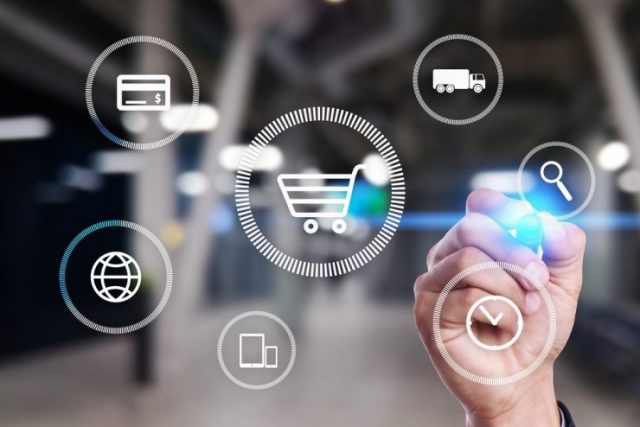Every single year, eCommerce takes a larger and larger bite out of traditional stores, retailers, and distributors. Increased customer demand, convenience, and a rise in connectivity is growing this trend upward
Today’s buyers live out of their mobile devices, are dependent on Amazon for their daily shopping needs, and are looking for ease, speed, and personalization when making purchases. This trend is impacting every buyer out there, regardless of how specialized the product or how complex the purchase used to be in the past.
All this means that eCommerce is surging ahead, with tons of opportunities being created for businesses looking to start selling. In this post, we’ll explore the popular selling models – B2C, B2B, to some lesser-known ones like B2B2B, D2C, B2G, and others.

What are the different eCommerce business models?
Determining how to position your eCommerce business involves taking many variables into account. Consider what type of product you sell, its profit margins, your business structure, and what kind of competition you’re stacked up against.
The most popular eCommerce business models
Traditionally, most online sellers target their customers with a B2C or a B2B model. In B2C, you target the general public, or consumers, and with B2B you target businesses.
B2C eCommerce
When most people think of an eCommerce business, B2C eCommerce is what comes to mind. B2C sellers have typically been mirroring the retail model, trying to replicate the purchase experience of the offline world. Nowadays, every brand from Walmart to Nike have eCommerce portals that drive a large chunk of their revenue. Some characteristics of B2C selling include:
- Large customer base. One advantage of selling to consumers is the sheer number of them. On the flipside, it’s also very competitive, so entering the right niches becomes important, as well as running targeted marketing campaigns.
- Individual buyers. Most of us tend to purchase products in low volumes for individual use. As a result, B2C sellers don’t need to concern themselves with contracts, bulk discounts, or complex payment methods.
- Emotional, one-off transactions. Consumers tend to buy based on feelings, emotions, and FOMO (fear of missing out). Marketing and sales is focused on getting customers emotionally invested in their purchase in order to drive sales.
B2B eCommerce
A B2B business model means that you sell to businesses rather than consumers. An example would be ERP solution that is sold to a manufacturing business, or forklift repair services being sold to a warehouse. So if you’re already selling to consumers, selling to business is not as easy as it may seem on the surface.
- Drawn-out purchases. There are less business customers, and they tend to research before committing to purchases. Selling to businesses becomes a lengthy process, one that focuses more on extracting long-term value out of each client.
- Long-term relationships. Unlike consumer orders, business orders are larger, more valuable, and take longer from start to finish. Businesses are interested in building long-term relationships with other businesses and growing them over time.
- Complexity and personalization. Businesses consist of many different stakeholders, departments and buying processes. They can also have unique negotiation, quoting and pricing requirements, making it more difficult to sell to them.
Lesser known & underrated eCommerce models
B2B2B eCommerce
The B2B2B model (business to business to business) builds on top of the traditional B2B model to include additional links in the chain. While a typical B2B product journey may start with a manufacturer selling to a retailer, who then sells to a customer, a B2B2B model can start with a manufacturer selling to a distributor, sub-distributor, wholesaler, retailer, b2b customer… and so on.
B2B2C eCommerce
The B2B2C model (business to business to customer) is a fusion of B2B and B2C, which allows B2B businesses to establish a secure link to the end-user. The advantages for the B2B seller is accessing the customer base their business client possesses.
An example of this would be a manufacturer selling to a subsidiary or partner distributor, having control over the selling process down to the end-user. This allows the manufacturer to offer better products and target more accurate promotions to its customers.
D2C eCommerce
The D2C model (direct to consumer) is a B2B business that bypasses the B2B2C model to sell straight to the customer. This helps sellers maximize market share, gaining them more brand recognition and loyalty as a result.
Many B2Bs prefer to expand into D2C without disrupting existing B2B sales channels or relationships with dealers and distributors. In this sense, a B2B eCommerce platform that supports multiple models can help them achieve that. Companies like Tesla have long worked out of a DTC model, foregoing a dealer network in favor of an online portal. It’s also a common business model in fashion (Adidas, H&M, Levi’s) and consumer goods (Nestle, Dollar Shave Club). They sell through marketplaces like Amazon D2С and their own sites, which allows them to maintain successful relationships with distributors and resellers.
B2B marketplaces
The most well-known B2C marketplace is Amazon. It allows third-party sellers to compete with each other on its platform. Similarly, a B2B marketplace connects multiple suppliers, distributors, or wholesalers together with a specific type of buyer.
B2B marketplaces tend to be closed off to the general public and be oriented towards B2B buyers such as wholesalers, suppliers, or other B2B customers. For some B2Bs, it’s an effective way of complimenting their product lines, broadening market reach and introducing new revenue streams.
B2E eCommerce
The B2E model (business to employee) is aimed at businesses looking to offer products and services to their employees in a centralized manner. An example of B2E eCommerce is businesses selling office stationery within the workplace or field employees ordering items such as specialized tools or parts.
B2G eCommerce
The B2G model (business to government) targets regional or federal governments as clients. An example would be an identification card supplier or an inspection services provider to a housing authority. It could also consist of products necessary for certain government transactions and activities.
G2G eCommerce
The G2G model (government to government) is a business relationship model between governments, usually a subset of e-Government. G2Gs facilitate the transaction of goods, services, and information to streamline various government processes.
Select an eCommerce platform for your model
With the right eCommerce solution, there is no need to choose one model at the expense of another. As time goes on, you may want to switch between business models as new opportunities emerge or certain markets dry up. This way, you’ll build resiliency and be able to quickly adapt to changing situations.
Many eCommerce vendors market primarily to the B2C camp, offering applications, extensions and upgrades that appeal to B2B sellers. Some of these B2B-friendly features do little more than enhance existing B2C product and pricing capabilities. This won’t work for all B2B sellers, particularly those whose customers may require corporate account structures, personalized product listings, or the ability to negotiate, quote, and quickly reorder items. Furthermore, a B2B eCommerce platform needs to be optimized for long-term business relationships and business-specific customer experiences.
Even if you only plan to sell B2C, a flexible platform prepares you for the long haul. With the right platform today, you’ll avoid replatforming tomorrow. Instead, you’ll be growing, scaling and pivoting when opportunity calls for it. Besides, these platforms can always be stripped down to B2C duty when needed, making them an ideal choice for ambitious brands that want to set up for success.
One such solution is offered by OroCommerce, a B2C, B2B, B2X and marketplace-focused platform. It offers features like customizable product catalogs, pricing, checkout, and multi-website capabilities allowing you to sell via multiple eCommerce models simultaneously.
Conclusion
The lesser-known business models listed in this post can present a unique opportunity to grow your business and expand your market share. The right strategy will allow you to maximize profitability, reduce costs and get a bigger piece of the large eCommerce pie.
An unconventional selling model will allow you to use the full potential of your network, strengthen relationships with other businesses, and build a strong brand.
Table of Contents








